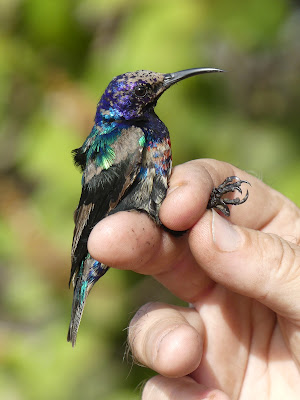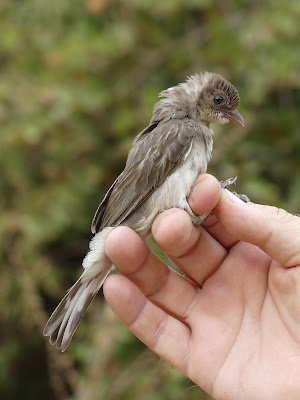Plans to cover Tanji bird reserve SE were quickly set aside when time was lost due to a bread collection delay, plus, due to sickness and a late change of plan, we were starting with 50% of the trainees originally planned for. Instead we flipped the Saturday/Sunday planning and simply dropped the few fixed nets at Tanji eco-lodge.
We still caught 27 birds with plenty of weavers to go around for AJ, FC & JN who also joined us a little later on. Things quietened quickly and although we relocated to Kenebery Junction water tanks it was too bright with birds seeing the net and changing their routes in and out.
Day 18.
Tanji bird reserve SE gave us around 30 birds to process today. There was our first Senegal Eremomela and Black-headed Weavers. We had three species of sunbird.
Yellow-fronted Tinkerbird (a small barbet)
Senegal Eremomela
Black-headed Weaver
Adult male Village weaver with traces of breeding plumage
on the head.
A brief meeting with some Dutch birders gave the trainees a chance to handle birds in front of a very small audience and even explain how one of the birds had been aged. We made it a short day as a demonstration was scheduled between midday and 2pm in Banjul and we wanted to ensure that all trainees were home in advance of the march, in case of trouble.
Day 19.
Following the problems at yesterday's demonstration some of the trainee's were reluctant to leave home and we ended up telling those prepared to come out not to, as the driver didn't want to drive anywhere and turned off his phone. We were fairly certain that the trouble was confined to Banjul and decided to bird Brufut woods, just up the road from Tanji and also look at two other sites, the first for birds and dragonflies and the second as a possible ringing site - if we saw the driver. We dropped the eco-lodge nets, in case we ended spending the entire day at our accommodation but the driver turned up before 7am after the boss had a word with him.
We had a slightly later breakfast, taking the first three rounds of the day before closing. It was nice to get a couple of Eurasian Reed Warblers, Beautiful and Splendid Sunbirds.
Beautiful Sunbird male
Splendid Sunbird male
African Thrush
There were very few birds and it would have been disappointing with the full team.
Then, on to Brufut woods, just a remnant of what must have been there before all the clearance for farming and building. The main thing that we recalled, apart from the birding being disappointing was all the rubbish. That hadn't changed.
Cattle browsing the rubbish at Brufut.
There were more butterflies than birds in Brufut woods.
A second species to identify later
The water pots attracted a lot of Laughing Doves
Lavendar Waxbill, Black-necked Weaver, Village Weaver, Bronze Mannikin, Blue-spotted and Black-billed Wood Doves, Greater Honeyguide and Red-billed Queleas were seen at the Brufut water pots.
Driving to the ponds just outside Tanji we managed to find Painted Snipe at the water's edge just when we'd been told to look for it.
Painted Snipe
Another butterfly to research for its name
Finally, we had a look at some scrubby bushes, quite close to the lodge, down at the coast just after an area of market gardens. A reedy area was also found to hold some very shallow areas. This may be suitable to ring. So, tomorrow's rest day is cancelled as in effect we had that today and we'll be back at Tanji SE tomorrow.
Day 20.
Today we were joined by AS, FC, MS & BM at Tanji reserve SE. Even at this point in the training, we continue to encounter new species.
A ring is carefully fitted on an immature Lesser Honeyguide
BM processes a weaver
FC gives the ring number while AS scribes
Day 21.
A slight change in location so a little clearance was needed today. We caught our first Common Nightingale among the handful of European migrants. The leading species over all was Yellow-crowned Gonolek (5) and one of the four Blue-cheeked Bee-eaters was a very obvious youngster.
Juvenile Blue-cheeked Bee-eater
The last 5 minutes before take-down time.
Day 22.
An unusually cool morning, followed by a windy day that was rather hot. Catching at Tanji SE was disappointing and we finished on just 8 birds.
Immature male Western Subalpine Warbler
There was plenty of time for a little photography when not checking nets or teaching the trainees.
Bearded Barbet
Blue-cheeked Bee-eater
Day 23.
An earlier start with 5 nets either close to the mangroves skirting the beach edge, or in the vegetation immediately behind and two larger mesh nets set by the lagoon for terns, gulls and possibly waders.
CL, FC and AS went paddling and set one full height and another two panel net. While DKL, MS, BM & AJ took care of the other nets. It was a good day with 25 birds processed. This included a retrap of the African Pygmy Kingfisher from 11 days before. The lagoon nets succeeded in catching several gulls and terns, but the combined weight was sufficient to break the central shelf string and the net failed to hold any. A single Caspian Tern was captured in the full height net on the subsequent round.
AS finally gets a chance to use large pliers to fit an 8mm ring.
Adult Caspian Tern
The bush nets also provided another new species. The Senegal Parrot was extracted by DKL, observed by AJ and ringed by FC. No ringers were harmed in the processing of this bird.
The tarsus was so short that none of our rings were suitable, instead a 9mm
steel ring was fitted on the tibia.
A full list of all species ringed by GRS throughout January will be published shortly.























































